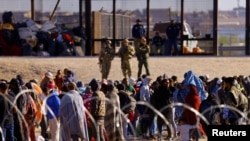The use of a public health policy known as Title 42, which allowed U.S. immigration officials to quickly expel migrants to their country of origin or Mexican border towns and denied them a chance at asylum, expires May 11.
With the end of Title 42 and the summer months approaching, an increase in migrant encounters is expected.
In anticipation of more encounters at the U.S.-Mexico border, Department of Homeland Security Secretary Alejandro Mayorkas recently said the Biden administration will announce changes there.
Mayorkas did not provide details but said immigration detention facilities will have more beds available to hold migrants facing deportation.
U.S. immigration officials reported more than 2 million migrant encounters along U.S. borders nationwide in fiscal 2022. Experts say the large number of encounters is the result of repeated entry attempts because of Title 42.
The largest cohort of migrant arrivals and expulsions were single adults in fiscal 2022. The U.S. Customs and Border Protection — often referred to as the CBP — releases border enforcement data monthly to explain what is happening. It includes apprehensions, encounters, and removals, among other actions.
But what do those terms mean?
Apprehensions
CBP defines an apprehension as "the physical control or temporary detainment of a person who is not lawfully in the United States, which may or may not result in an arrest."
Migrants — often in large family groups — who cross U.S. borders outside official ports of entry requesting asylum are temporarily apprehended and eventually expelled from the U.S. back to their countries of origin.
In its monthly reports before March 2020, CBP listed apprehensions individually. But after March 2020, when the Trump administration imposed the Title 42 health order, CBP created a new category called "encounters," which combined apprehensions and expulsions.
Encounters
Migrants who are either apprehended and expelled from the country or were apprehended but allowed to go through routine removal proceedings, which include seeking asylum while in the U.S., are categorized as encounters.
Cesar Cuauhtemoc Garcia Hernandez, a professor at the Moritz College of Law at Ohio State University and an expert on migration studies, told VOA that apprehensions are a type of encounter.
"When somebody, for example, presents themselves at a port of entry requesting admission into the United States, and then they're turned back because they're inadmissible, then that counts as an encounter," he said.
He explained that migrants who were expelled under Title 42 can be encountered multiple times and counted each time.
Expulsions
Migrants can be expelled from the country after they have been detained at the border under Title 42. They are taken to the port of entry closest to where they entered and are sent back across the border. Expulsion is not the same as deportation, which is a legal process. An expulsion can take hours or sometimes days.
Expedited removals
This process gives immigration officers the power to deport certain non-citizens quickly and efficiently without a hearing before a U.S. immigration judge.
Expedited removals can apply to migrants while they are being processed at a port of entry, or have entered the United States unlawfully, or who cannot prove they have been in the country for at least two years. The guideline can also apply to immigrants who have committed fraud or misrepresentation.
Immigration officers can apply expedited removal to individuals who entered the U.S. without authorization and were encountered within 100 miles of the Mexican or Canadian borders and apprehended within two weeks of arrival into the U.S.
Deportations
In a deportation process, U.S. Immigration and Customs Enforcement formally accuses a non-citizen of being removable. People who are placed in deportation proceedings have the right to legal representation and the right to present a case in front of an immigration judge, who will decide whether to give a departure order.
Are we going back to using Title 8?
No. Even during the pandemic, Title 8 was always in force at any U.S. border.
Title 8 is the federal code of laws dealing with immigration, and those arriving at the border without documents or trying to enter between ports of entry can be removed without their case being decided by an immigration court.
But in anticipation of the May 11 end of Title 42, the Biden administration began testing faster asylum screening for migrants detained crossing into the U.S. without authorization.
Those who can't establish a legal basis to remain in the United States will be quickly removed through a process known as expedited removal under Title 8 authority.
If a migrant wants to claim asylum, however, an asylum officer interviews them before removal, deportation or the granting of authorization to enter the U.S. to continue the asylum process.






